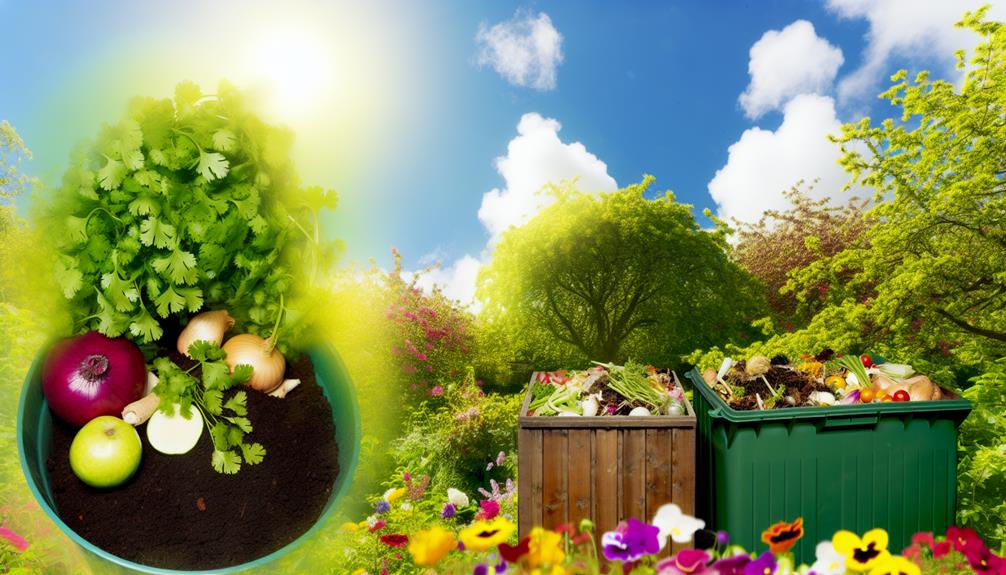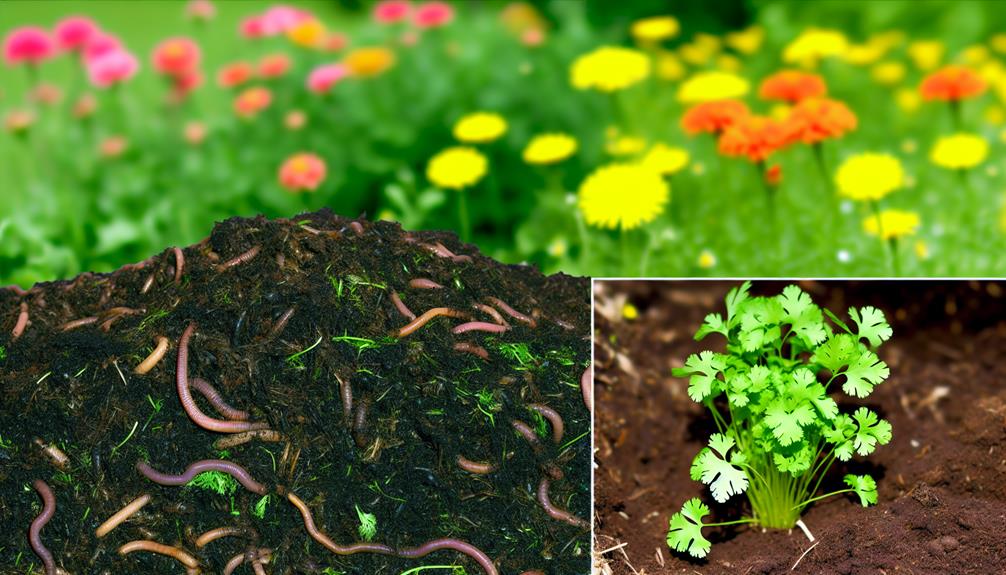

Yes, you can compost cilantro. Start by chopping it into smaller pieces using kitchen shears or a knife. This helps it break down faster. Mix cilantro with brown materials like dried leaves or paper to maintain a balanced compost pile. Turning the compost regularly will guarantee even decomposition and enhance microbial activity.
Avoid adding large stems or cilantro with pesticide residues. Finished compost will be dark, crumbly, and earthy. Use it to enrich garden beds or as mulch. You’ll also boost your compost’s nutrient content, particularly nitrogen. For more detailed composting tips and practices, keep on exploring.
Composting cilantro not only reduces kitchen waste but also enriches your garden soil with essential nutrients. By adding cilantro to your compost pile, you create a natural soil amendment that boosts your garden’s health. The organic matter in cilantro breaks down, releasing valuable nutrients back into the soil. This process enhances the soil structure, making it more fertile and better able to retain moisture. As a result, your plants can grow stronger and healthier.
When you compost cilantro, you’re contributing to a sustainable gardening practice that benefits the entire community of gardeners. You help reduce landfill waste and promote a greener environment. Cilantro, like other green materials, is rich in nitrogen, which is an important component for a balanced compost. By mixing it with brown materials, you create an ideal compost blend that accelerates decomposition and produces rich, dark humus.
Using compost as a soil amendment improves garden health by increasing microbial activity and nutrient availability. This enriched soil supports robust plant growth, leading to higher yields and more vibrant gardens. By composting cilantro, you’re not just improving your garden; you’re also fostering a sense of belonging within the gardening community.
To prepare cilantro for composting, start by cutting it into smaller pieces to speed up the decomposition process. You’ll want to use sharp kitchen shears or a knife for this task. When it comes to cutting methods, aim for pieces that are around one to two inches long. This size guarantees the cilantro breaks down more efficiently, integrating well with other compost materials.
Before you get started, inspect the cilantro for any non-compostable items like rubber bands or twist ties. Removing these helps keep your compost pure and effective. If you’ve got a large batch, consider using a cutting board to make the process easier and faster.
Storing your cilantro before composting is also important. If you’re not adding it to your compost pile immediately, keep it in a breathable container like a paper bag. This prevents mold and rot, which could create unwanted odors. Avoid plastic bags, as they trap moisture and can cause the cilantro to become slimy.
Also Read: Can You Compost Bread?
When adding cilantro to your compost, you’re boosting its nutrient content, especially with nitrogen. Cilantro breaks down quickly, so mix it with brown materials like leaves or paper to balance the compost.

Follow best practices by turning your pile regularly to guarantee even decomposition and avoid any unpleasant odors.
Adding cilantro to your compost pile enriches it with essential nutrients, enhancing the overall fertility of the finished compost. Cilantro contributes a variety of micronutrients, including potassium, calcium, and magnesium, that are crucial for plant growth.
By adding cilantro, you also support microbial activity essential for breaking down organic matter, which in turn boosts soil fertility.
When you incorporate cilantro into your compost, you’re not just discarding kitchen scraps; you’re actively improving the health of your soil.
Here’s how cilantro can benefit your compost:
Incorporating cilantro into your compost mix fosters a sense of community within your garden. You’re not just recycling waste; you’re nurturing a living system that enriches your garden and contributes to a sustainable environment.
Cilantro breaks down quickly in a compost pile, speeding up the decomposition process and contributing to faster compost production. Its soft leaves and stems decompose faster than many other plant materials.
When you add cilantro to your compost, you’ll notice that it helps heat up the pile, enhancing microbial activity. The temperature impact is important because it accelerates the breakdown of organic matter.
Maintaining proper moisture levels is also essential. Cilantro holds a fair amount of water, so it helps keep the compost moist. However, balance is key; too much moisture can lead to anaerobic conditions, slowing down decomposition. Keep an eye on moisture levels and adjust as needed.
Here’s a quick guide to understanding cilantro’s decomposition rate:
| Factor | Impact on Decomposition | Tips |
|---|---|---|
| Temperature | Speeds up the process | Maintain 135-160°F for best results |
| Moisture Levels | Keeps compost moist | Ensure it’s damp, not soggy |
| Leaf and Stem Size | Decomposes quickly | Chop into smaller pieces |
| Microbial Activity | Increases | Turn pile regularly |
| Overall Compost Time | Reduces significantly | Combine with other greens |
To maximize the benefits of cilantro in your compost, focus on integrating it with other compost materials for best results. Cilantro decomposes quickly, so it’s best to mix it with a variety of organic matter. This balance guarantees efficient decomposition and nutrient-rich compost.
Consider these best practices when adding cilantro to your compost:
Also Read: Can You Compost Bag?
Achieve the perfect compost by maintaining a balanced mix of green and brown materials. Green materials, like kitchen waste, provide nitrogen and help maintain moisture levels. These include fruit and vegetable scraps, coffee grounds, and, yes, cilantro.
Brown materials, on the other hand, offer carbon and help with aeration. Think of items like dried leaves, straw, and cardboard.
For your compost to thrive, you need both types. A good rule of thumb is to mix three parts brown materials to one part green materials. This ratio guarantees that your compost pile stays balanced and breaks down efficiently. Too much green material can create a smelly, soggy mess, while too much brown material can slow down the decomposition process.
When adding cilantro and other kitchen waste to your compost, always mix them with brown materials. This helps to control moisture levels and prevents your compost from becoming too wet.
Turn your compost regularly to aerate it and speed up the decomposition process. By doing this, you’re not just creating nutrient-rich compost; you’re also fostering a sense of community with nature and others who share your green-thumb passion.
When composting cilantro, be sure to avoid adding large stems, as they take longer to decompose.
Keep an eye out for any pesticide residues, which can harm beneficial microorganisms in your compost.
Make sure you maintain a balanced green-to-brown ratio to promote efficient decomposition.
Often, people mistakenly include large cilantro stems in their compost, which can slow down the decomposition process. To guarantee your compost breaks down efficiently, consider the importance of stem removal. By paying attention to stem size, you’ll help create a more balanced compost pile.
Here are three key steps to follow for effective cilantro composting:
Many people overlook the presence of pesticides on cilantro, which can introduce harmful chemicals into your compost. When you compost cilantro, pesticide residue can linger and potentially harm beneficial organisms in your compost pile. To avoid this, you should be mindful of the source of your cilantro.
First, you should check if your cilantro has organic certification. Organic cilantro is grown without synthetic pesticides, making it a safer choice for composting. If you can’t find organic cilantro, thoroughly wash the cilantro to reduce pesticide residue. Keep in mind that washing won’t remove all chemicals, but it can notably reduce the amount present.
Here’s a quick comparison to help you decide:
| Type | Pesticide Risk | Recommended for Compost |
|---|---|---|
| Organic Cilantro | Low | Yes |
| Washed Cilantro | Medium | Yes, with caution |
| Unwashed Cilantro | High | No |
A common mistake in composting is failing to balance the green and brown materials properly. When you’re composting cilantro or any other organic matter, achieving the right mix is essential for a healthy compost pile. Green materials like cilantro, veggie scraps, and coffee grounds provide nitrogen, while brown materials like dried leaves, cardboard, and straw add carbon.
To avoid common pitfalls, consider these three key tips:
To speed up cilantro decomposition, you should chop the leaves and stems into smaller pieces before adding them to the compost pile. This increases the surface area, allowing microbes to break down the material more efficiently.
Next, focus on turning the pile regularly. By doing so, you introduce much-needed oxygen into the mix, which helps aerobic bacteria thrive and accelerates the decomposition process. Aim to turn your compost pile at least once a week, ensuring that the cilantro and other materials are well-mixed and aerated.
Another effective method involves employing various aeration techniques. You can insert a compost aerator tool or a simple garden fork to create air pockets within the pile. These pockets facilitate airflow, preventing the pile from becoming compacted and anaerobic, which would slow down decomposition.
Additionally, maintain the right moisture level. Cilantro and other green materials provide moisture, but you might need to add water if the pile becomes too dry. The goal is to keep the compost as damp as a wrung-out sponge.
Also Read: Can You Compost Aubergine?
Once you’ve managed the decomposition process effectively, you’ll want to look for signs that your compost is ready to use.

First, verify the moisture content is just right. Your compost should be damp, like a wrung-out sponge, not too wet or dry. Excess moisture can lead to foul odors, while too little can hinder the decomposition process.
Second, importance control plays an important role. During active decomposition, your compost pile will be hot, often between 120-160 degrees Fahrenheit. However, when it’s ready, the temperature will drop to match the ambient air temperature. This indicates that microbial activity has slowed and the composting process is complete.
Finally, examine the physical appearance and smell of your compost. Ready compost is dark, crumbly, and earthy-smelling. You shouldn’t be able to distinguish the original materials, such as cilantro stems or leaves. If it still looks like a pile of kitchen scraps, it needs more time.
Here are three signs your compost is ready:
Frequently, you’ll find that utilizing finished compost can significantly improve the health and productivity of your garden. This nutrient-rich soil amendment enhances soil structure, water retention, and nutrient availability.
To maximize the benefits of your compost, start by spreading a layer about 2-3 inches thick across your garden beds. Work it into the top few inches of soil using a garden fork or tiller.
For garden enhancement, incorporate compost into planting holes for individual plants or mix it into potting soil for container gardening. This practice guarantees that your plants receive a steady supply of nutrients, promoting robust growth and higher yields.
Compost also serves as an excellent mulch. Spread it around the base of plants to help retain moisture, suppress weeds, and moderate soil temperature. This protective layer can lead to healthier plants and reduce the need for chemical fertilizers and pesticides.
If you’re starting a new garden, blend compost with native soil to create a fertile foundation. Over time, regularly adding compost to your garden will build up organic matter, enhancing the overall health and resilience of your soil.
Yes, cilantro can attract pests, but you can prevent this by maintaining good compost aeration and pest prevention techniques. Turn the pile regularly and cover food scraps with brown materials to feel like a composting pro.
When you add cilantro to your compost, it helps with pH balancing and nutrient contribution. By doing so, you’re ensuring a healthier compost pile that benefits everyone in your gardening community, promoting a sense of belonging and shared success.
You can definitely compost cilantro stems along with the leaves. Their nutrient content enriches your compost, and they have a quick decomposition time. Including both parts helps your compost community thrive and feel more complete.
You should wash cilantro before composting it. Using proper washing techniques removes pesticides and dirt, ensuring cleaner compost. This small step enhances your compost’s quality, making your gardening community proud of your eco-friendly contributions.
It’s not safe to compost cilantro with signs of disease or pests. Effective disease management and pest control start by ensuring only healthy plant material goes into your compost. Let’s keep our gardens thriving together!
By composting cilantro, you’ll enrich your soil with valuable nutrients. Prepare it by chopping into smaller pieces, and balance it with brown materials.
Avoid common mistakes like adding too much cilantro at once. Speed up decomposition by turning your compost regularly. Know it’s ready when it’s dark and crumbly.
Use this nutrient-rich compost to improve your garden’s health. Following these tips guarantees you get the most out of your composting efforts.
